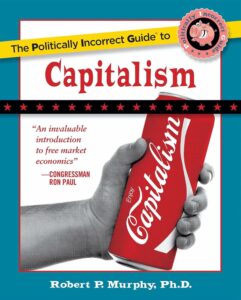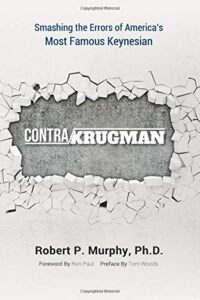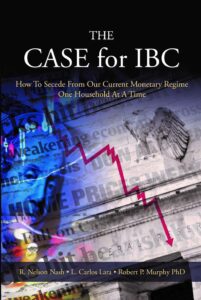Paul Krugman, Liquidationist
In the spirit of Thanksgiving, I am not going to accuse Krugman of all sorts of perfidy. I genuinely want one of his defenders to explain this recent post.
Krugman is arguing that the cases of Ireland and Iceland show that the types of remedies he has been suggesting, work out much better than the remedies suggested by his small-government critics. Here’s an excerpt:
[D]espite epic irresponsibility on the part of its bankers, on a scale that makes Irish bankers look like Jimmy Stewart, at this point Iceland actually looks a bit better than Ireland.
I wrote about the surprising resilience of Iceland a while back. Since then, Ireland has had a bit of growth, while Iceland had a modest setback in the first half of 2010 (partly thanks to the volcano)…
Slightly worse (but within measurement error) GDP performance in Iceland, but substantially less bad employment performance. And don’t get me started on Latvia and Estonia.
…
Oh, and while the IMF is demanding that Ireland cut minimum wages and reduce unemployment benefits, its mission to Iceland praised the “focus on preserving Iceland’s valued Nordic social welfare model.”What’s going on here? In a nutshell, Ireland has been orthodox and responsible — guaranteeing all debts, engaging in savage austerity to try to pay for the cost of those guarantees, and, of course, staying on the euro. Iceland has been heterodox: capital controls, large devaluation, and a lot of debt restructuring — notice that wonderful line from the IMF, above, about how “private sector bankruptcies have led to a marked decline in external debt”. Bankrupting yourself to recovery! Seriously.
And guess what: heterodoxy is working a whole lot better than orthodoxy.
So yes, “What’s going on here?” Is Krugman saying that it was the fuddy-duddy austerians who were saying, “The government needs to assume all debts in the banking sector,” while it was the bold Keynesians who were saying, “Nah, just let the banks fail, and bankruptcy court will handle it”?
Maybe that’s how the chips fell when it came to recommendations for Ireland and Iceland, but that sure as heck wasn’t how things played out in the U.S. No, Krugman & Co. were saying capital injections into the big banks were crucial. Austrian-types were saying, “Let the big banks collapse. That won’t destroy assets, but instead will simply recognize reality. Bankruptcy courts will reallocate the remaining assets into the hands of more responsible institutions.”
I am sure that’s what we were arguing, because at the time Tyler Cowen told us we were being naive and that bankruptcy would take too long–hence the need for TARP.
(P.S. If someone wants to provide links, I’ll update this post. I told my son I “wouldn’t work” today, and this is borderline working, even though I derive much pleasure from criticizing Krugman.)
This Year, I’m Thankful That I’ve Been Bearish on the Dollar
This sounds a little ominous (HT2 someone-on-Facebook):
St. Petersburg, Russia – China and Russia have decided to renounce the US dollar and resort to using their own currencies for bilateral trade, Premier Wen Jiabao and his Russian counterpart Vladimir Putin announced late on Tuesday.
Chinese experts said the move reflected closer relations between Beijing and Moscow and is not aimed at challenging the dollar, but to protect their domestic economies.
“About trade settlement, we have decided to use our own currencies,” Putin said at a joint news conference with Wen in St. Petersburg.
The two countries were accustomed to using other currencies, especially the dollar, for bilateral trade. Since the financial crisis, however, high-ranking officials on both sides began to explore other possibilities.
The yuan has now started trading against the Russian rouble in the Chinese interbank market, while the renminbi will soon be allowed to trade against the rouble in Russia, Putin said.
“That has forged an important step in bilateral trade and it is a result of the consolidated financial systems of world countries,” he said.
Quantitative Easing Explained Explained
[Sic.]
So the video itself got more than 2 million hits in the first week. The interview with its creator currently has 810 views. You heard it here first (and last).
Division of Labor, for High Schoolers
OK here is the video of the talk I gave last week on the division of labor at the Mises Institute high school seminar. (Note: The opening jokes are referring to something Mark Thornton did in the prior talk. BTW if someone watches his talk, can you give me the exact time he sets up my joke? Then I’ll edit the link.)
I Predict Gerald Celente Won’t Be Invited Back to Fox & Friends…
Holy cow, he doesn’t pull any punches when it comes to the TSA (HT2 LRC):
A Plug for the EPJ “Daily Alert”
Bob Wenzel is not paying me to say this, and I’m not getting any kind of commission, though it is true he gave me a free subscription. So interpret this however you like…
His EPJ Daily Alert is actually very interesting and lives up to what it purports to be: it is a deeper layer of analysis that would help investors more than what you get for free on the main EPJ blog.
For example, obviously Wenzel blogged about the FBI raids of hedge funds yesterday as the news broke. But in his Daily Alert, he expanded the analysis. Here’s an excerpt:
I note that a few media outlets have run the top holdings of the three hedge funds where FBI raids were conducted today. While this may be interesting, the real focus should be on the thinly traded positions in a fund that could be in forced liquidation. If the thinly traded positions are at the same time a significant position in the company, downside price action could be huge if forced liquidation takes place. Over the years, I have seen forced liquidation situations like this, perhaps a half dozen times.
They can be some of the most profitable trades you can imagine. Two specific situations come to mind. Once when some nut job managed to gain control of a huge position in Safeguard Scientific. When it was discovered he didn’t have any money, his position was liquidated quickly (over a two week period) and crushed the stock. The same thing happened when the SEC moved in on a small market maker. It destroyed the firm. The stocks, in which the firm made a market and held inventory, were crushed.
In both cases, you could have made money on the short side, but also interestingly enough, you could have also made major money on the long side after the intense selling pressure subsided. This is a very rough guess, but I’m thinking the stocks rebounded by 50% or more.
Thus, there are a few things to do here. If you have a lot of time, start looking at the positions of the three firms that were raided to day, , Diamondback, LevelGroup and Loch, under the theory that serious arrests will take place at these firms. Other options include watching the news for arrests at firms and how it will impact firms. If it is likely firms will close, where arrests have taken place, those are the firms where you want to find thinly traded stocks that will be liquidated.
So to be clear, I enjoy the EPJ Daily Alert not because of “stock tips,” but rather because it gives an often different way of analyzing the financial news of the day. It provides a more comprehensive framework, within which you make your own investment decisions.
If you want to give it a try, check out this link. If you enter offer code “Bob Murphy,” you will pay the same price as those who do not.







Recent Comments